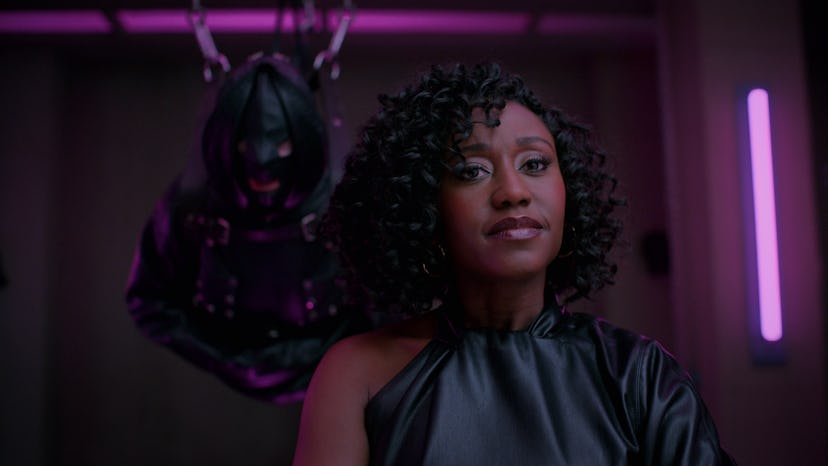Streaming
How Bonding Filmed Its Intense BDSM Scenes
From sourcing the gear to coaching the actors through long hours in bondage.

One of the first things you see in Bonding Season 2 is a man suspended facedown from the ceiling in full-body leather. Dominatrix Mistress Mira (Nana Mensah) stands in front of him, harshly reprimanding Tiff (Zoe Levin) and Pete (Brendan Scannell) for their "lack of consent, good judgment, and vetting practices." Then she turns back to the man. "Are you all right, pet?" she asks gently.
The scene doubles as a knowing reference to the backlash the Netflix series received following the release of Season 1. While creator Rightor Doyle based Bonding on his own experiences as the assistant to a domme and intended to portray the BDSM and kink communities more authentically than movies like 50 Shades of Grey, Season 1 was criticized for glossing over conversations about consent and boundaries as well as inaccuracies in costuming and dialogue. "The people who didn't like [Season 1] the most were the people that I was trying to show respect to," Doyle tells Bustle.
For Season 2, he brought on intimacy coordinator Olivia Troy, who runs a consulting agency and has worked on projects featuring queer characters, sex workers, and those in the BDSM/kink communities for over a decade. She worked across every aspect of production, addressing the fact that Tiff wore a submissive's collar in Season 1 and helping to outfit Pete in custom-made pieces from real-life fetish leather king David Samuel Menkes. Troy also sourced BDSM gear from actual New York City dungeons and wrote in scenes to challenge the notion that Dominant/submissive (D/s) relationships are inherently disrespectful or cruel. "The relationship is often quite caring and quite devoted," says Troy, who also worked in the writers' room. "There's mutual respect, mutual affection, and mutual appreciation for what each person is bringing into the experience."
While many of Bonding's BDSM scenes are more elaborate than what you might see in "vanilla" productions — at one point, Mira oversees a client in a sleep sack with an apparatus controlling his oxygen flow — Troy says that as with any sex scene, the key is prioritizing communication and consent. With the performers who were experienced in BDSM, Troy discussed safety concerns and comfort levels before filming. For those that weren't, a lot of the preparation revolved around establishing boundaries and talking through the physical challenges of the scene. Troy likens her job to being "an emotional support coach" who "holds [the actor's] hand through the vulnerability that happens when it's something they might not be so familiar with."
As a result, fluidity on set was key. "If in the script it says they rip each other's clothes off and an actor says, 'I don't feel like taking my clothes off,' I'm like, 'OK, let's put you in a jacket,'" Doyle says. "To me, it's more [important that] the actor feels comfortable and does the thing that we need emotionally, [rather] than physically [following the script]."
The result is a show that much more accurately (albeit not perfectly) captures a community often misrepresented on-screen, if it's represented at all. “The one thing I can say about 50 Shades of Grey is that because of its ubiquity, that opened the door for all of these conversations [about BDSM]," Troy says. With Bonding, she simply hopes to make those conversations more "positive and fruitful."
This article was originally published on